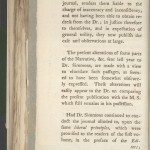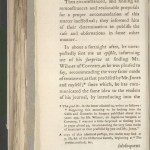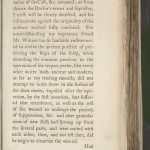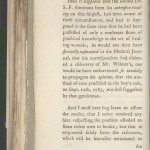A History of the Practice of Trepanning the Skull: 1. Frontispiece and Introduction
Robert Mynors, a pioneer of surgical treatment in 18th century Birmingham
Robert Mynors was one of the lesser-known medical figures of the West Midlands in the late 18th century. His reputation has been eclipsed by John Ash, who founded Birmingham’s General Hospital, Erasmus Darwin, probably England’s best doctor at the time, William Small one of the creators of the Lunar Society and William Withering, discoverer of the scientific properties of the heart drug, digitalis.
Mynors, nevertheless was an important figure, contributing to a widening understanding of surgical techniques and medical care. Little is known about his life. In Swinney’s Birmingham Directory of 1774, he is described as a “Surgeon and Man-midwife”, living at “14 Square”. Surgeons were apprenticed to their trade and had a lower status than university trained doctors, but they were gradually acquiring an improving reputation as their knowledge of anatomy and medical science increased. Mynors contributed to this trend. He wrote Practical Thoughts on Amputations in 1783, which dealt with techniques of surgical amputation and the post-operative care of amputees. The multi-tailed bandage is credited as his invention. The book was dedicated to two doctors, Thomas Kirkland, from whom he learned the basics of surgery and William Withering. His second publication in 1785, A History of the Practice of Trepanning the Skull and the after-treatment; with observations upon a new method of care, explores the techniques and treatment involved in this form of surgery. Trepanning was one of the few operations performed on patients before the advent of anaesthetics in the 19th century. It involved removing a portion of the skull to relieve a number of head injuries.
In about 1780 Robert Mynors moved to Snow Hill and by 1783 he had rented part of his house to James Millar, a local artist. Millar produced portraits of several Birmingham figures including John Baskerville, the printer, Francis Eginton, the engraver and John Freeth, the poet. He also painted Robert Mynors and his family. The Mynors family originally came from Uttoxeter in Staffordshire, and then moved to Weatheroak Hall in Alvechurch, Worcestershire. The portrait, which dates from the 1790s, shows the Mynors in, it seems, Weatheroak Hall and appears to have several allegorical features, including a blazing fire in the background, which may be alluding to the Priestley Riots of 1791. It is located in the Dining Room of Soho House Museum, Handsworth, Birmingham, and is the only known portrait of Robert Mynors.
The extracts from his two books illustrate his contributions to surgery and the care of patients.
INTRODUCTION
ON the 3d of June, 1784, a Narrative of the Case of a Fractured Skull, and observations thereon, were sent to Dr. S.F.Simmons, requesting their insertion in the number of the London Medical Journal then in the press. In the course of a few days, the authors received this answer from him: “it comes too late for the number now in the press, but it shall certainly have a place in the next.”
The Dr. however has since thought proper to publish an abridgment only of the communication, and without mentioning such intention to the authors. As the form, in which it appears in the
iv.
Introduction.
journal, renders them liable to the charge of inaccuracy and inconsistency, and not having been able to obtain redress from the Dr.; in justice therefore to themselves, and in expectation of general utility, they now publish the case and observations at large.
The present alterations of some parts of the Narrative, &c. sent last year to Dr. Simmons, are made with a view to elucidate such passages, as seemed to have been somewhat obscurely expressed. These alterations will easily appear to the Dr. on comparing the present publication with the M.S. which still remains in his possession.
Had Dr. Simmons continued to conduct the journal alluded to, upon the same liberal principles, which were promised to the readers of the first volume, in the preface of the
v.
Introduction.
Editors;* and had he thence been induced to correct the style of the M.S. sent him, and to arrange its materials in a manner, which he might think becoming the Editor of that work; had he not suppressed any facts, omitted, or infeebled any arguments; and had he not perverted the sense in the former part of one paragraph, thence misapplying the reasoning in the latter part: the authors acknowledge, that they should have been greatly obliged to him, as such a step would have effectually superseded the present publication.
*”Their numerous readers may be assured, that as they engaged in this undertaking on the most liberal principles, so they will continue to prosecute it with the utmost candour, and with unremitting attention.” See preface to the 1st volume of the London Medical Journal.
In consequence of this declaration, the credulous authors entrusted Dr. Simmons with their M.S. to publish in the Medical Journal.
vi.
Introduction
Thus circumstanced, and finding all remonstrances and reasonable proposals for a proper accommodation of this matter ineffectual; they informed him of their determination to publish the case and observations in some other manner.
In about a fortnight after, he unexpectedly sent me an epistle, informing me of his surprize at finding Mr. Wilmer of Coventry, as he was pleased to say, recommending the very same mode of treatment as that practised by Mr. Jones and myself;* since which he has communicated the same idea to the readers of his journal, by introducing into the
*The good Dr. in the letter alluded to, writes as follows:
“Happening this morning to be looking onto the Cases and Remarks in Surgery published about five years ago, by Mr. Wilmer, an ingenious Surgeon at Coventry, I was not a little surprized at finding him in pages 46 and 47, recommending the very same mode of treatment as that practised by you and Mr. Jones.”
A copy of this identical passage, the reader may find at p. 88, &c. of the Historical Sketch, beginning at “The present method, &c.
vii.
Introduction.
subsequent number of that work, the following paragraph.
“In addition to the Case of fractured Scull, described in a former part of this volume (page 278), we think it right to observe, that the mode of treatment adopted in that case was first suggested by Mr. Wilmer, an ingenious Surgeon at Coventry, in his Cases and Remarks in Surgery, published in 1779. In that work he contends, that it is not absolutely necessary to remove any portion of the scalp, even when the scull is extensively fractured; and in proof of this, he observes, that in several cases of fractured scull, in which it was necessary to apply the trephine more than once, he has seen the cure accomplished, without removing any portion of the scalp. My. Wilmer adds, that the wounds were healed in half the time that must have been employed, if excision
viii.
Introduction.
had taken place; and that he has seen but one case, thus treated, where the exfoliation of the bone was necessary. – The case related by our correspondent merits attention, as it affords an additional proof of the safety and efficacy of the method of cure recommended by Mr. Wilmer.” See Lond. Med. Journal, vol. V, No. 4, p.440.
Such has been the liberal treatment from Dr. S.F.Simmons to his correspondent!
—“subtilius quam utilius nonnulli disputant”, says Peter Paaw!* and without making any further reply, I may safely leave the reader to form his own opinion; after requesting him only to compare the above paragraph with the following Historical Sketch, particularly with that part of it beginning at(r) p.83 and ending p.97, and with the
*Perri Paaw Comment, in Hippoc. De Capitis Volneribus.
ix.
Introduction.
Narrative of the Case, &c. annexed, as from thence the Doctor’s errors and sophistry, I trust, will be clearly detected, and his insinuations against the originality of the authors method fully confuted. For notwithstanding my ingenious friend Mr. Wilmer has so laudably endeavoured to revive the ancient practice of preserving the flaps of the scalp, when denuding the cranium previous to the operation of the trepan; yet he, like every other writer both ancient and modern, as far as my reading extends, did not attempt to unite them to the surface of the dura mater, exposed after the operation, by the first intention, but suffered that membrane, as well as the rest of the wound to undergo the process of suppuration, &c. and after granulations of the new flesh had sprung up from the several parts, and were united with each other, then, and not till then, did he begin to cicatrize the wound.
x.
Introduction.
Had it happened that the learned Dr. S. F. Simmons from his extensive reading on the subject, had been aware of these circumstances, and had it happened at the same time that he had been possessed of only a moderate share of practical knowledge in the art of healing wounds; he would not then have shrewdly insinuated in the Medical Journal, that his correspondent had claimed a discovery of Mr. Wilmer’s, nor would he have endeavoured so candidly to propagate his opinion, that the method of cure practised in the boy’s case, on Sept. 12th, 1783, was first suggested by that gentleman.
And I must here beg leave to assure the reader, that I never received any hint respecting the practice alluded to from either men or books; but that it originated solely from the resources, which will be hereafter mentioned in
xi.
Introduction.
the observations; and which were communicated to Dr. Simmons last June to have been published in the London Medical Journal.
In penning those few observations which were sent to the Dr. I then studiously avoided saying any more than what I thought would be sufficient to excite the attention of surgeons to this important subject; but from the interpretation which that accurate discriminator Dr. S. F. Simmons has been pleased to give of my practice, I am now obliged to depart from my first intention, and to make the following additions, which have necessarily enlarged the work to its present size.
Besides the ready opportunity which the Historical Sketch will afford to my readers of comparing the former practices, with that which I now recommend,
xii.
Introduction.
as I flatter myself that it will be found to have been executed with fidelity and attention, it may serve to shew by what very slow steps mankind approach towards perfection, and how much they are contended with copying and imitating their predecessors: for when with a glance, as it were, we can discriminate the whole that has been done, we are the better enabled to judge how much still remains to be done.
Birmingham Feb. 27th. 1785.
Sources and Further ReadingI am grateful to Doreen Hopwood, Birmingham Libraries and Jane McArdle, Birmingham Museums and Art Gallery for supplying information about Robert Mynors.
Bailey, W, Bailey’s Western and Midland Directory of Merchants’ and Tradesmen’s useful Companion for the Year 1783. (Birmingham, Rollaston and Pearson, 1783)
Hill, Joseph and Dent, Robert, Memorials of the Old Square. (Birmingham, Achilles Taylor, 1897). This contains the only account of Mynors’ importance.
Mynors, Robert, Practical Thoughts on Amputations &c., (Birmingham, Piercy and Jones, 1783).
Mynors, Robert, A History of the Practice of Trepanning the Skull and the after-treatment; with observations upon a new method of care (Birmingham, Piercy and Jones for G Robinson, 1785).
Swinney, Myles, The New Birmingham Directory and Gentleman’s and Tradesman’s Compleat Memorandum Book. (Birmingham, M Swinney, 1774).
















